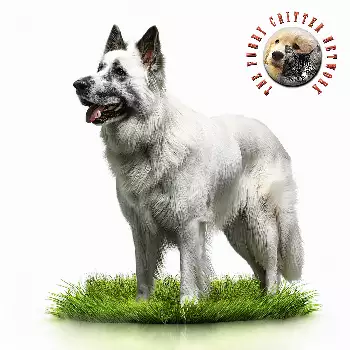The health profile of the Istrian Sheepdog reflects both the benefits of its working heritage and the challenges associated with maintaining a rare breed with a limited genetic pool. Overall, this breed tends to be hardy and resilient, characteristics developed through centuries of natural selection in the demanding environment of the Karst region. However, like all purebred dogs, Istrian Sheepdogs can be affected by certain health conditions that require attention from owners and breeders committed to maintaining the breed's long-term health and vitality.
The breed's general constitution demonstrates the robustness typical of working dogs developed for harsh environmental conditions. Their thick, weather-resistant coat, strong bone structure, and muscular build reflect genetic selection for durability and functionality rather than appearance alone. This functional breeding approach has contributed to a breed that typically enjoys good health when provided with appropriate care, nutrition, and exercise.
Life expectancy for the Istrian Sheepdog typically ranges from 10 to 12 years, which is standard for dogs of their size and build. This lifespan reflects the breed's generally sound health while acknowledging the natural effects of size on longevity. Individual dogs may exceed this range with excellent care, appropriate nutrition, and good genetic background, while others may experience shorter lifespans due to health challenges or environmental factors.
Musculoskeletal health represents an area of particular importance for this active, large breed. Hip and elbow dysplasia, conditions affecting the proper formation and function of these crucial joints, can occur in Istrian Sheepdogs as in most large breeds. Responsible breeders typically screen breeding stock using radiographic evaluation to identify dogs with good joint structure and reduce the likelihood of producing offspring with these conditions. Maintaining appropriate weight and providing suitable exercise can help minimize the impact of minor joint problems.
The breed's cardiovascular health benefits from their active lifestyle and working heritage, though large breeds can be susceptible to certain heart conditions. Regular veterinary monitoring, including cardiac evaluation during routine health checks, helps identify any developing concerns early. The breed's exercise requirements naturally support cardiovascular fitness, though sudden changes in activity levels or extreme exercise should be avoided, particularly in older dogs.
Digestive health in Istrian Sheepdogs generally remains stable with appropriate nutrition and feeding practices. However, like many large, deep-chested breeds, they can be susceptible to gastric dilation-volvulus (bloat), a serious condition requiring immediate veterinary attention. Preventive measures include feeding smaller, more frequent meals, avoiding vigorous exercise immediately after eating, and monitoring for symptoms such as unsuccessful attempts to vomit, abdominal distension, or signs of distress.
The breed's distinctive coat requires attention to skin health, particularly during seasonal shedding periods when the dense undercoat is released. Regular brushing helps prevent matting and allows for early detection of skin problems, parasites, or other concerns. The thick coat provides excellent protection against weather but can also harbor ticks, burrs, and other environmental hazards that require regular inspection and removal.
Eye health in Istrian Sheepdogs generally remains good throughout their lives, though routine monitoring for age-related changes helps maintain visual function and comfort. The breed's dark pigmentation around the eyes provides natural protection against sun damage, while their working heritage has favored dogs with good vision and healthy eyes. Annual eye examinations as part of routine veterinary care help identify any developing concerns.
Reproductive health considerations are particularly important given the breed's small global population and the need to maintain genetic diversity. Responsible breeding practices include health screening of breeding stock, careful selection to avoid inbreeding, and collaboration between breeders to maintain genetic health. Female dogs typically have normal reproductive cycles and whelping ability, though their large size requires appropriate whelping facilities and monitoring.
The breed's mental health and behavioral wellness are closely linked to their physical health, as Istrian Sheepdogs require purposeful activity and mental stimulation to maintain optimal wellbeing. Dogs that lack appropriate outlets for their natural behaviors may develop stress-related health problems or behavioral issues that impact their overall quality of life. Providing appropriate environment, exercise, and mental challenges supports both physical and psychological health.
Nutritional health requirements reflect the breed's size, activity level, and coat maintenance needs. High-quality nutrition supports their muscular build, coat condition, and energy requirements while maintaining appropriate weight to reduce stress on joints and other body systems. Working dogs or those with higher activity levels may require increased caloric intake, while less active individuals need careful weight management to prevent obesity-related health problems.
Preventive healthcare for Istrian Sheepdogs follows standard canine protocols while accounting for breed-specific considerations. Regular vaccinations, parasite prevention, and dental care provide the foundation for long-term health. The breed's outdoor lifestyle and working heritage may increase exposure to certain parasites or environmental hazards, requiring vigilant prevention and monitoring programs.
Age-related health changes in Istrian Sheepdogs typically follow patterns common to large breeds, with gradual changes in mobility, sensory function, and energy levels. Senior dogs benefit from adjusted exercise programs, modified nutrition, and increased veterinary monitoring to address age-related concerns promptly. Many dogs maintain their guardian instincts and alert nature well into their senior years, though physical capabilities may gradually decline.
Health monitoring for Istrian Sheepdogs should include attention to breed-specific considerations such as their tendency toward independence, which may mask early signs of illness or discomfort. Owners must be particularly observant for subtle changes in behavior, appetite, or activity patterns that might indicate developing health concerns. Regular veterinary examinations provide opportunities to detect problems before they become serious.
Common Health Issues
- Hip and elbow dysplasia due to large size and active lifestyle requiring joint monitoring
- Gastric dilation-volvulus (bloat) risk associated with deep chest and large size
- Seasonal coat and skin management needs during heavy shedding periods
Recommended Health Testing
- Hip and elbow radiographic evaluation for breeding dogs and early detection programs
- Annual comprehensive veterinary examinations including cardiac and joint assessment
- Regular monitoring for signs of bloat and education on emergency response protocols

